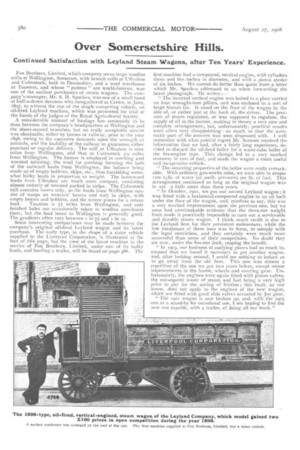Over Sotnersetshire Hills.
Page 2

If you've noticed an error in this article please click here to report it so we can fix it.
Fox Brothers, Limited, which company owns large woollen mills at 'Wellington, Somerset, with branch mills at Uffculine and Culmstock, both in Devonshire, and a wool warehouse at Taunton, and whose " puttees" are world-famous, was one of the earliest purchasers of steam wagons. The company's manager, Mr. S. H. Sparkes, was one of a small band of half-a-dozen devotees who foregathered at Crewe, in June, 1897, to witness the run of the single competing vehicle, an oil-fired Leyland machine, which was presented for trial at the hands of the judges of the Royal Agricultural Society. A considerable amount of haulage has constantly to be (lone between the company's headquarters at Wellington and the above-named branches, but no really acceptable service was obtainable, either by horses or railway, prior to the year i898, owing to the excessive demands upon the strength of animals, and the inability of the railway to guarantee either punctual or regular delivery. The mill at Uffculnie is nine miles from Wellington, and that at Culmstock six miles from Wellington. The former is employed in combing and worsted spinning, the wool for combing forming the bulk of the outward loads from Wellington, the balance being made up of empty bobbins, skips, etc., thus furnishing somewhat bulky loads in proportion to weight. The homeward loads from 1_7ficuline are much more compact, consisting almost entirely of worsted packed in strips. The Culmstock mill contains looms only, so the loads from Wellington consist of warps on weavers' beams and weft in skips, with empty beams and bobbins, and the woven pieces for a return
load. Taunton is 74 miles from Wellington, and only finished bales are occasionally taken to woollen merchants there, but the load home to Wellington is generally good. The gradients often vary between i in 7t, and i in 110.
Some interesting comparisons may be made between the company's original oil-fired Leyland wagon and its latest purchase. The early type, in the shape of a sister vehicle supplied to the Liverpool Corporation, is illustrated at the foot of this page, but the view of the latest machine in the service of Fox Brothers, Limited, under one of its bulky loads, and hauling a trailer, will be found on page 588. The first machine had a compound, vertical engine, with cylinders three and five inches in diameter, and with a piston stroke of six inches. We cannot do better than quote from a letter which Mr. Sparkes addressed to us when forwarding the latest photograph. He writes : ' The inverted vertical engine was bolted to a plate carried on four wrought-iron pillars, and was enclosed in a sort of large biscuit tin. It stood on the floor of the wagon by the side of, or rather just at the back of, the driver. The pressure of steam regulated, or was supposed to regulate, the supply of oil to the burner, making in theory a very nice and complete arrangement ; but, unfortunately, practical results were often very disappointing—so much so that the automatic part of the concern was soon dispensed with. I well remember with what painful regret Mr. Sumner received the information that we had, after a fairly long experience, decided to discard the oil-fired boiler for a water-tube boiler of the fire-engine type. This change led to a very marked economy in cost of fuel, and made the wagon a more useful and inexpensive vehicle.
" The steaming properties of the boiler w.ere really remarkable. With ordinary gas-works coke, we were able to evaporate 6A.). of water (at 255lb. pressure) per lb. of fuel. This arrangement continued as long as the original wagon was in use a little more than three years.
" In October, toot, we got our second Leyland wagon ; it was fitted with a horizontal-compound engine in an oil bath under the floor of the wagon, and, needless to say, this was a very marked improvement upon the previous one, but we soon had unmistakable evidence that the three-ton weight limit made it practically impossible to turn out a serviceable and durable steam wagon. I think much credit is due to the Leyland firm for their persistent endeavours, while the low maximum of three tons was in force, to comply with the legal restriction, and they certainly were much more successful than some of their competitors. No doubt they are now, under the five-ton limit, reaping the benefit.
" In 1903, our business at outlying places had so much increased that we found it necessary to get another wagon, and, after looking around, I could see nothing to induce us to go away from the old firm. This one was almost a repetition of the one we got two years before, except minor improvements in the frame, wheels and steering gear. Un fortunately, the engines were again fitted with piston valves, the consequent waste of steam and fuel being a very high price to pay for the saving of friction ; this fault, as you know, does not apply to the engines of the new wagon, which are fitted with good slide valves actuated by Joy gear.
"'The tgot wagon is now broken up, and. with the 1933 one as a stand-by for occasional use, I am hoping to find the new one capable, with a trailer, of doing all our work."




















